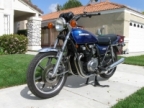coil impedance
- arobsum
-
Topic Author
- Offline
- User
-

Registered
- Posts: 566
- Thanks: 10
Re: coil impedance
13 Dec 2006 19:36
well, i took a chance and put them on with no resistors, just to see if it would work...no go!! no spark, no cool engine vroom! nothing! bad coils? they are used...maybe even off another make...
Please Log in or Create an account to join the conversation.
- Bluemeanie
-

- Offline
- User
-

Registered
- Posts: 2516
- Thanks: 15
Re: coil impedance
20 Dec 2006 06:17
SpokeWheels, I'm running a set of Andrews coils (#6262B) that check out at 3.1 ohms, same number as yours?
Post edited by: Bluemeanie, at: 2006/12/20 09:18
Post edited by: Bluemeanie, at: 2006/12/20 09:18
1980 KZ650F1, Bought new out the door for $2,162.98!
Attachments:
Please Log in or Create an account to join the conversation.
- KaZooCruiser
-
- Offline
- User
-

Registered
- Posts: 456
- Thanks: 7
Re: coil impedance
09 Jan 2007 15:22
wiredgeorge wrote:
The reason for the automotive use of ballast resistors was due to the fact that the automakers found that a six-volt coil boosted spark output with a voltage higher than 6 volts. By running a resistor in series with the 12 volt feed, the voltage was dropped to around 9 volts once the resistor heated up. Chevy used a ballast wire, while Chrysler used wire embedded in a ceramic block which was mounted on the firewall near the brake master cylinder on late sixties-early seventies units. Once electronic ignitions became standard, point burning was no longer an issue, which brings me to my question;
I can see why 3ohm impedance is needed for backwards compatibility regarding Dyna coils as replacements for stock ignition systems, but why would that be relevant or necessary where points have been replaced with magnetically induced triggers? I see a lot of siamese coils in automotive applications, and it seems an automotive recyling center (junkyard) might prove an excellent alternative to out of stock and overpriced aftermarket suppliers. I can even see potential use for coil-over modification, eliminating coil wire concerns, at little to no cost.
I doubt the Kawasaki ballast resistor is still available but you could try bikebandit.com or some other OEM parts source. I have been told that it is possible to buy automotive inline ballast resistors at autoparts stores but I asked at a couple and they don't appear to be a stock item anymore. Apparantly at one time, they were fairly common for some reason but are not used in more modern applications.
The reason for the automotive use of ballast resistors was due to the fact that the automakers found that a six-volt coil boosted spark output with a voltage higher than 6 volts. By running a resistor in series with the 12 volt feed, the voltage was dropped to around 9 volts once the resistor heated up. Chevy used a ballast wire, while Chrysler used wire embedded in a ceramic block which was mounted on the firewall near the brake master cylinder on late sixties-early seventies units. Once electronic ignitions became standard, point burning was no longer an issue, which brings me to my question;
I can see why 3ohm impedance is needed for backwards compatibility regarding Dyna coils as replacements for stock ignition systems, but why would that be relevant or necessary where points have been replaced with magnetically induced triggers? I see a lot of siamese coils in automotive applications, and it seems an automotive recyling center (junkyard) might prove an excellent alternative to out of stock and overpriced aftermarket suppliers. I can even see potential use for coil-over modification, eliminating coil wire concerns, at little to no cost.
The following user(s) said Thank You: GPz550D1
Please Log in or Create an account to join the conversation.
- steell
-

- Offline
- User
-

Registered
- Posts: 6849
- Thanks: 208
Re: coil impedance
09 Jan 2007 15:42
KaZooCruiser wrote:
I believe it was actually done for easier starting. Every car that I ever saw with either a ballast resister or a calibrated resistance wire had two wires going to the positive terminal on the coil. One wire came from the resister (or resister wire), and the other wire came directly from the start terminal on the ignition switch. That allowed for a really hot spark when starting, but reduced power to the coil to keep it from overheating during normal use (and burning the points).
Those were the days
The reason for the automotive use of ballast resistors was due to the fact that the automakers found that a six-volt coil boosted spark output with a voltage higher than 6 volts. By running a resistor in series with the 12 volt feed, the voltage was dropped to around 9 volts once the resistor heated up. Chevy used a ballast wire, while Chrysler used wire embedded in a ceramic block which was mounted on the firewall near the brake master cylinder on late sixties-early seventies units. Once electronic ignitions became standard, point burning was no longer an issue, which brings me to my question;
I believe it was actually done for easier starting. Every car that I ever saw with either a ballast resister or a calibrated resistance wire had two wires going to the positive terminal on the coil. One wire came from the resister (or resister wire), and the other wire came directly from the start terminal on the ignition switch. That allowed for a really hot spark when starting, but reduced power to the coil to keep it from overheating during normal use (and burning the points).
Those were the days

KD9JUR
Please Log in or Create an account to join the conversation.
- KaZooCruiser
-
- Offline
- User
-

Registered
- Posts: 456
- Thanks: 7
Re: coil impedance
09 Jan 2007 15:56
steell wrote:
KaZooCruiser wrote:
I believe it was actually done for easier starting. Every car that I ever saw with either a ballast resister or a calibrated resistance wire had two wires going to the positive terminal on the coil. One wire came from the resister (or resister wire), and the other wire came directly from the start terminal on the ignition switch. That allowed for a really hot spark when starting, but reduced power to the coil to keep it from overheating during normal use (and burning the points).
Those were the days
Easier starting / hotter spark. . .I seem to remember that part, now that you mention it. Chrysler sometimes used a dual-element ballast block, for the start versus run issues. Cracked ceramic blocks due to heat expansion. . .customer complaints. . .it starts fine, until I let the key go. . .
Please Log in or Create an account to join the conversation.
- loudhvx
-

- Offline
- KZr Legend
-

Registered
- Posts: 10864
- Thanks: 1619
Re: coil impedance
10 Jan 2007 10:18
The issue is dwell. Because points have a fixed dwell angle, the dwell time reduces as RPMs increase. This means spark energy decreases as RPMs increase. If you give enough dwell time to charge the coil sufficiently at high RPMs, there will be way too much dwell time at idle. This will burn the points. A ballast heats up at low RPMs and reduces the current through the points and coil. This reults in a lower apparent voltage at the coil.
The ballast is only needed to resolve the difference between high RPM and low RPM. It is switched out during startup so that the spark is maximized during cranking.
Electronic ignitions don't have points to burn, but they do heat up if the dwell is too long. This is just as bad. However, the magnetic pickup designs allow for a variable dwell angle. The Kaw design varies from about 100 degrees at idle to about 120 degrees at high RPMs. This doesn't seem like a big difference, but the duty cycle is enough of a difference to keep the ignitor happy.
Basically, the ballast has been replaced by electronics which vary the dwell.
In the early days of electronic ignitions, though, they still occasionally retained the ballast to supplement the electronics. Perhaps to be safe, or because the electronics hadn't quite caught up to ballasts performance, or maybe even just because it was cheap. Chrysler and even Kawasaki (and probably others), still had ballasts on some early electronic ignitions. They dropped them later.
The ballast is only needed to resolve the difference between high RPM and low RPM. It is switched out during startup so that the spark is maximized during cranking.
Electronic ignitions don't have points to burn, but they do heat up if the dwell is too long. This is just as bad. However, the magnetic pickup designs allow for a variable dwell angle. The Kaw design varies from about 100 degrees at idle to about 120 degrees at high RPMs. This doesn't seem like a big difference, but the duty cycle is enough of a difference to keep the ignitor happy.
Basically, the ballast has been replaced by electronics which vary the dwell.
In the early days of electronic ignitions, though, they still occasionally retained the ballast to supplement the electronics. Perhaps to be safe, or because the electronics hadn't quite caught up to ballasts performance, or maybe even just because it was cheap. Chrysler and even Kawasaki (and probably others), still had ballasts on some early electronic ignitions. They dropped them later.
1981 KZ550 D1 gpz.
Kz550 valve train warning.
Other links.
Kz550 valve train warning.
Other links.
Please Log in or Create an account to join the conversation.
Moderators: Street Fighter LTD

